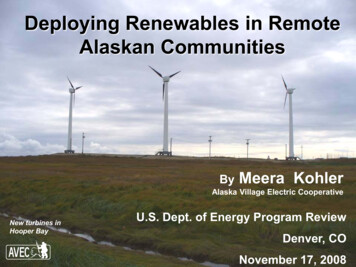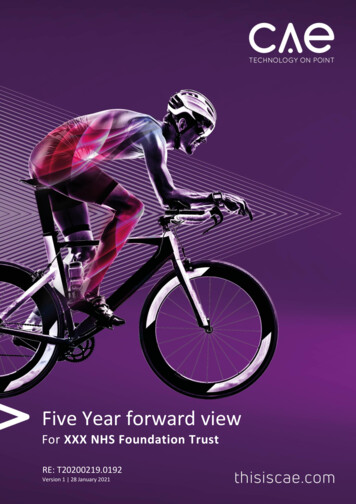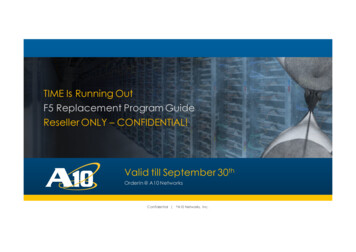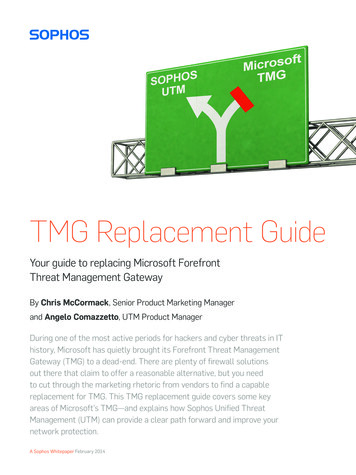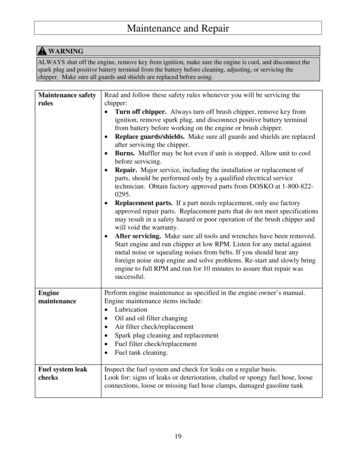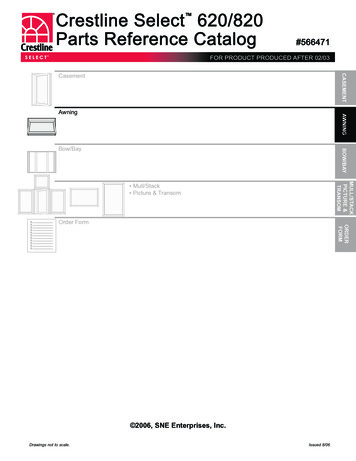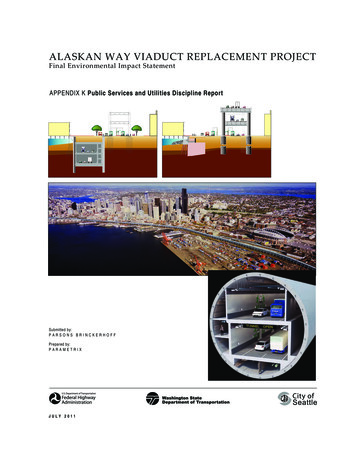
Transcription
ALASKAN WAY VIADUCT REPLACEMENT PROJECTFinal Environmental Impact StatementAPPENDIX K Public Services and Utilities Discipline ReportSubmitted by:PARSONS BRINCKERHOFFPrepared by:PARAMETRIXJULY 2011
Alaskan Way Viaduct Replacement ProjectFinal EISPublic Services and Utilities Discipline ReportThe Alaskan Way Viaduct Replacement Project is a joint effort between the Federal HighwayAdministration (FHWA), the Washington State Department of Transportation (WSDOT), theCity of Seattle. To conduct this project, WSDOT contracted with:Parsons Brinckerhoff999 Third Avenue, Suite 3200Seattle, WA 98104In association with:Coughlin Porter Lundeen, Inc.EnviroIssues, Inc.GHD, Inc.HDR Engineering, Inc.Jacobs Engineering Group, Inc.Magnusson Klemencic Associates, Inc.Mimi Sheridan, AICPParametrix, Inc.Power Engineers, Inc.Shannon & Wilson, Inc.William P. Ott Construction ConsultantsSR 99: Alaskan Way Viaduct Replacement ProjectPublic Services and Utilities Discipline ReportFinal EISJuly 2011
This Page Intentionally Left Blank
TABLE OF CONTENTSChapter 1 Introduction and Summary. 11.1 Introduction . 11.2 Build Alternatives Overview . 21.2.1 Bored Tunnel Alternative Overview . 31.2.2 Cut-and-Cover Tunnel Alternative Overview . 41.2.3 Elevated Structure Alternative Overview . 41.3 Summary . 51.3.1 Characteristics of Existing Public Services and Utilities . 61.3.2 Operational Effects and Mitigation . 61.3.3 Construction Effects and Mitigation . 81.3.4 Tolling Effects and Mitigation. 11Chapter 2 Methodology . 132.1 Study Area . 132.2 Applicable Regulations and Guidelines . 132.3 Data Needs and Sources. 142.4 Analysis of Existing Conditions . 142.5 Analysis of Environmental Effects . 152.5.1 Operational Effects . 152.5.2 Construction Effects . 152.6 Determination of Mitigation Measures . 15Chapter 3 Studies and Coordination. 173.1 Studies. 173.1.1 Public Services . 173.1.2 Utilities . 173.1.3 Coordination . 183.1.4 Public Agencies and Service Providers . 183.1.5 Private Utility or Service Providers . 193.1.6 Communications Providers. 19Chapter 4 Affected Environment . 214.1 Public Services . 214.1.1 Fire Stations and Emergency Medical Services . 214.1.2 Law Enforcement Services . 234.1.3 Postal Services . 244.1.4 Disaster Preparedness and Emergency Management . 254.1.5 Public Schools . 264.1.6 Solid Waste Collection, Disposal, and Recycling . 274.2 Utilities . 294.2.1 Electrical Power . 294.2.2 Water . 304.2.3 Sanitary Sewer and Storm Drainage . 314.2.4 Natural Gas . 344.2.5 Steam . 344.2.6 Petroleum . 344.2.7 Telecommunications. 34SR 99: Alaskan Way Viaduct Replacement ProjectPublic Services and Utilities Discipline ReportFinal EISJuly 2011i
Chapter 5 Operational Effects, Mitigation, and Benefits . 375.1 Operational Effects of the Viaduct Closed (No Build Alternative). 385.1.1 Scenario 1: Sudden Unplanned Closure of the Viaduct . 385.1.2 Scenario 2: Catastrophic Failure and Collapse . 395.2 Operational Effects of the Build Alternatives on Public Services . 405.2.1 Response Times for Public Services . 425.2.2 Accidents and Safety (SR 99 Mainline and Ramps) . 445.2.3 Hazardous Materials . 445.3 Build Alternatives Operational Effects on Utilities . 445.3.1 Operational Effects on Utilities Common to All Build Alternatives. 455.3.2 Bored Tunnel Alternative Operational Effects on Utilities . 465.3.3 Cut-and-Cover Tunnel Alternative Operational Effects on Utilities . 485.3.4 Elevated Structure Alternative Operational Effects on Utilities . 505.4 Mitigation of Operational Effects . 515.4.1 Public Services . 515.4.2 Utilities . 525.5 Operational Benefits . 52Chapter 6 Construction Effects and Mitigation . 556.1 Construction Effects Common to All Build Alternatives . 556.1.1 Construction Effects on Public Services . 556.1.2 Constructions Effects on Utilities . 576.2 Effects of Concurrent Construction . 606.2.1 Effects on Public Services . 606.2.2 Effects on Utilities . 606.3 Bored Tunnel Alternative Utilities Effects . 616.3.1 South Portal . 616.3.2 Bored Tunnel . 626.3.3 North Portal. 636.3.4 Viaduct Removal. 656.3.5 Battery Street Tunnel Decommissioning. 666.4 Cut-and-Cover Tunnel Alternative Utilities Effects . 676.5 Elevated Structure Alternative Utilities Effects . 676.6 Mitigation of Construction Effects Common to All Build Alternatives . 676.6.1 Mitigation of Effects on Public Services . 686.6.2 Mitigation of Effects on Utilities . 706.7 Bored Tunnel Alternative Mitigation Measures . 726.7.1 Permeation Grouting. 736.7.2 Compaction Grouting . 736.7.3 Compensation Grouting . 736.7.4 Ground Freezing . 746.7.5 Underpinning . 746.8 Cut-and-Cover Tunnel Alternative Mitigation Measures . 746.9 Elevated Structure Alternative Mitigation Measures . 75Chapter 7 Tolling . 777.1 General Description of Tolling . 777.2 Effects of Tolling on Public Services Common to All Alternatives . 777.3 Effects of Tolling on Utilities Common to All Alternatives . 77SR 99: Alaskan Way Viaduct Replacement ProjectPublic Services and Utilities Discipline ReportFinal EISJuly 2011ii
7.4 Mitigation of Tolling Effects on Public Services Common to All Alternatives . 787.5 Mitigation of Tolling Effects on Utilities Common to All Alternatives . 78Chapter 8 References . 79LIST OF EXHIBITSExhibit 1-1. Other Projects Included in the Alaskan Way Viaduct and Seawall Replacement Program . 2Exhibit 4-1. Public Services Within or Near the Study Area . 22Exhibit 4-2. Seattle Fire Stations in or Near the Study Area . 23Exhibit 4-3. Postal Services in the Study Area . 25Exhibit 4-4. Distribution of Seattle Public School Transportation in the Study Area . 26SR 99: Alaskan Way Viaduct Replacement ProjectPublic Services and Utilities Discipline ReportFinal EISJuly 2011iii
ACRONYMS AND ABBREVIATIONSBMPbest management practiceCityCity of SeattleDoITSeattle Department of Information TechnologyEBIElliott Bay InterceptorEISEnvironmental Impact StatementELIElectric Lightwave, LLCFWHAFederal Highway AdministrationI-5Interstate 5kVkilovoltLOSlevel of serviceNEPANational Environmental Policy ActNFPANational Fire Protection AssociationNRDSNorth Recycling and Disposal StationProgramAlaskan Way Viaduct and Seawall Replacement ProgramprojectAlaskan Way Viaduct Replacement ProjectPSEPuget Sound EnergySCLSeattle City LightSFDSeattle Fire DepartmentSODOSouth of DowntownSPDSeattle Police DepartmentSPUSeattle Public UtilitiesSRState RouteSRDSSouth Recycling and Disposal StationTBMtunnel boring machineWACWashington Administrative CodeWSDOTWashington State Department of TransportationSR 99: Alaskan Way Viaduct Replacement ProjectPublic Services and Utilities Discipline ReportFinal EISJuly 2011iv
Chapter 1 INTRODUCTION AND SUMMARY1.1 IntroductionThis discipline report was prepared in support of the Final Environmental ImpactStatement (EIS) for the Alaskan Way Viaduct Replacement Project (project). TheFinal EIS and all of the supporting discipline reports evaluate the Viaduct Closed(No Build Alternative) in addition to the three build alternatives: the BoredTunnel Alternative (preferred), the Cut-and-Cover Tunnel Alternative, and theElevated Structure Alternative. The designs for both the Cut-and-Cover Tunneland the Elevated Structure Alternatives have been updated since the 2006Supplemental Draft EIS to reflect that the section of the viaduct betweenS. Holgate Street and S. King Street is being replaced by a separate project, andthe alignment at S. Washington Street no longer intrudes into Elliott Bay. Allthree build alternatives are evaluated with tolls and without tolls.The Federal Highway Administration (FHWA) is the lead federal agency for thisproject, primarily responsible for compliance with the National EnvironmentalPolicy Act (NEPA) and other federal regulations, as well as distributing federalfunding. Per the NEPA process, FHWA was responsible for selecting thepreferred alternative. FHWA has based its decision on the information evaluatedduring the environmental review process, including information contained in the2010 Supplemental Draft EIS (WSDOT et al. 2010) and previous evaluations in2004 and 2006. After issuance of the Final EIS, FHWA will issue its NEPAdecision, called the Record of Decision (ROD).The 2004 Draft EIS (WSDOT et al. 2004) evaluated five Build Alternatives and a NoBuild Alternative. In December 2004, the project proponents identified the Cutand-Cover Tunnel Alternative as the preferred alternative and carried the RebuildAlternative forward for analysis as well. The 2006 Supplemental Draft EIS (WSDOTet al. 2006) analyzed two alternatives—a refined Cut-and-Cover Tunnel Alternativeand a modified rebuild alternative called the Elevated Structure Alternative. Aftercontinued public and agency debate, Governor Gregoire called for an advisory voteto be held in Seattle. The March 2007 ballot included an elevated structurealternative (differing in design from the current Elevated Structure Alternative) anda surface-tunnel hybrid alternative. The citizens voted down both alternatives.After the 2007 election, the lead agencies committed to a collaborative process(referred to as the Partnership Process) to find a solution to replace the viaductalong Seattle’s central waterfront. In January 2009, Governor Gregoire, KingCounty Executive Sims, and Seattle Mayor Nickels announced that the agencies hadreached a consensus and recommended replacing the aging viaduct with a boredtunnel, which is being evaluated in this Final EIS as the preferred alternative.SR 99: Alaskan Way Viaduct Replacement ProjectPublic Services and Utilities Discipline ReportFinal EISJuly 20111
1.2 Build Alternatives OverviewThe Alaskan Way Viaduct Replacement Project is one of several independentprojects developed to improve safety and mobility along State Route (SR) 99 andthe Seattle waterfront from the South of Downtown (SODO) area to Seattle Center.Collectively, these individual projects are often referred to as the Alaskan WayViaduct and Seawall Replacement Program (Program). See Exhibit 1-1.Exhibit 1-1. Other Projects Included in the Alaskan Way Viaduct and SeawallReplacement ndent Projects That Complement the Bored Tunnel AlternativeElliott Bay Seawall ProjectXIncluded inalternativeIncluded inalternativeAlaskan Way Surface Street ImprovementsXIncluded inalternativeIncluded inalternativeAlaskan Way Promenade/Public SpaceXIncluded inalternativeIncluded inalternativeFirst Avenue Streetcar EvaluationXIncluded inalternativeIncluded inalternativeElliott/Western t enhancementsXNot proposed2Not proposed2S. Holgate Street to S. King Street ViaductReplacement ProjectXXXMercer West ProjectXXXTransportation Improvements to MinimizeTraffic Effects During ConstructionXXXSR 99 Yesler Way Vicinity FoundationStabilizationXXXS. Massachusetts Street to Railroad Way S.Electrical Line Relocation ProjectXXXProjects That Complement All Build AlternativesThese specific improvements are not proposed with the Cut-and-Cover Tunnel and ElevatedStructure Alternatives; however, these alternatives provide a functionally similar connectionwith ramps to and from SR 99 at Elliott and Western Avenues.2. Similar improvements included with the Bored Tunnel Alternative could be proposed with thisalternative.1.This Final EIS evaluates the cumulative effects (Chapter 7) of all the buildalternatives; however, direct and indirect environmental effects of theseSR 99: Alaskan Way Viaduct Replacement ProjectPublic Services and Utilities Discipline ReportFinal EISJuly 20112
independent projects within the Program will be considered separately inindependent environmental documents.The S. Holgate Street to S. King Street Viaduct Replacement Project, currentlyunder construction as a separate project, was designed to be compatible with anyof the three viaduct replacement alternatives analyzed in this Final EIS.1.2.1Bored Tunnel Alternative OverviewThe Bored Tunnel Alternative (preferred alternative) includes replacing SR 99 with abored tunnel and associated improvements, such as relocating utilities located on orunder the viaduct, removing the viaduct, decommissioning the Battery Street Tunnel,and making improvements to the surface streets in the tunnel’s south and northportal areas.The Bored Tunnel Alternative would replace SR 99 between S. Royal BroughamWay and Roy Street with two lanes in each direction. Beginning at S. RoyalBrougham Way, SR 99 would be a side-by-side surface roadway that woulddescend to a cut-and-cover tunnel. At approximately S. King Street, SR 99 wouldthen become a stacked bored tunnel, with two southbound travel lanes on the topand two northbound travel lanes on the bottom.The bored tunnel would continue under Alaskan Way S. to approximatelyS. Washington Street, where it would curve slightly away from the waterfront andthen travel under First Avenue beginning at approximately University Street. AtStewart Street, it would extend north under Belltown. At Denny Way, the boredtunnel would travel under Sixth Avenue N., where it would transition to a side-byside surface roadway at about Harrison Street.Access and exit ramps in the south would include a southbound on-ramp to andnorthbound off-ramp from SR 99 that would be built in retained cuts and feeddirectly into a reconfigured Alaskan Way S. with three lanes in each direction.Alaskan Way S. would have one new intersection, with the new east-west crossstreet at S. Dearborn Street.The Bored Tunnel Alternative also includes reconstructing a portion of the eastwest S. King Street and widening the East Frontage Road from S. Atlantic Street toS. Royal Brougham Way to accommodate truck turning movements. RailroadWay S. would be replaced by a new one-lane roadway on which northbound trafficcould travel between S. Dearborn Street and Alaskan Way S.Access from northbound SR 99 and access to southbound SR 99 would be providedvia new ramps at Republican Street. The northbound off-ramp to Republican Streetwould be provided on the east side of SR 99 and routed to an intersection at DexterAvenue N. Drivers would access the southbound on-ramp via a new connectionwith Sixth Avenue N. on the west side of SR 99.SR 99: Alaskan Way Viaduct Replacement ProjectPublic Services and Utilities Discipline ReportFinal EISJuly 20113
Surface streets in the north portal area would be reconfigured and improved. Thestreet grid between Denny Way and Harrison Street would be connected byrestoring a section of Aurora Avenue just north of the existing Battery Street Tunnelportal. John, Thomas, and Harrison Streets would be connected as cross streets.1.2.2Cut-and-Cover Tunnel Alternative OverviewUnder the Cut-and-Cover Tunnel Alternative, a six-lane stacked tunnel wouldreplace the existing viaduct between S. Dearborn Street and Pine Street. AtPine Street, SR 99 transitions out of the cut-and-cover tunnel near the Pike StreetHillclimb and would cross over the BNSF Railway rail tracks on a side-by-sideaerial roadway. Near Lenora Street, SR 99 would transition to a retained cutextending up to the Battery Street Tunnel portal. SR 99 would travel underElliott and Western Avenues. The southbound on-ramp from Elliott Avenue andthe northbound on-ramp at Western Avenue would be rebuilt. The northboundon-ramp from Bell Street and the southbound off-ramp at Battery Street andWestern Avenue would be closed and used for maintenance and emergencyaccess only.The Battery Street Tunnel would be retrofitted for improved seismic safety. Theexisting tunnel safety systems would be updated. Improvements would includewidening of the south portal, a new fire suppression system, updated ventilation,and new emergency egress structures near Second, Fourth, and Sixth Avenues.From the north portal of the Battery Street Tunnel, SR 99 would be lowered in aretained cut to about Mercer Street, with improvements and widening north toAloha Street. Broad Street would be closed between Fifth and Ninth Avenues N.,allowing the street grid to be connected. Mercer Street would continue to crossunder SR 99 as it does today. However, it would be widened and converted froma one-way to a two-way street, with three lanes each way and a center turn lane.Access to and from SR 99 would be provided at Denny Way and Roy Street. Inthe northbound direction, drivers could exit at Republican Street. In addition,Thomas and Harrison Streets would be reconstructed as bridges crossing over thelowered SR 99 to reconnect the street grid for vehicles and pedestrians.The Cut-and-Cover Tunnel Alternative would replace the existing seawall withthe west wall of the tunnel. Alaskan Way would be rebuilt with this alternative.1.2.3Elevated Structure Alternative OverviewThe Elevated Structure Alternative would replace the existing viaduct mostlywithin the existing right-of-way. The Elevated Structure Alternative wouldreplace the seawall between S. Jackson and Broad Streets.In the central section of Seattle’s downtown, the Elevated Structure Alternativewould replace the existing viaduct with a stacked aerial structure along theSR 99: Alaskan Way Viaduct Replacement ProjectPublic Services and Utilities Discipline ReportFinal EISJuly 20114
central waterfront. The SR 99 roadway would have three lanes in each direction,with wider lanes and shoulders than the existing viaduct.The existing ramps at Columbia and Seneca Streets would be rebuilt andconnected to a new drop lane. This extra lane would improve safety for driversaccessing downtown Seattle on the midtown ramps.The existing SR 99 roadway would be retrofitted, starting between Virginia andLenora Streets up to the Battery Street Tunnel’s south portal. SR 99 would travel overElliott and Western Avenues to connect to the Battery Street Tunnel. This aerialstructure would transition to two lanes in each direction as it enters the Battery StreetTunnel by dropping a northbound lane to Western Avenue. The Battery StreetTunnel would be upgraded with new safety improvements, which include a firesuppression system, seismic retrofitting, and access and egress structures. Thevertical clearance would be increased to about 16.5 feet throughout the length of thetunnel. However, unlike the Battery Street Tunnel improvements with the Cut-andCover Tunnel Alternative, the roadway at the south portal would not be widened.The Elliott and Western Avenue ramps would be rebuilt, and the existingsouthbound off-ramp at Battery Street and Western Avenue and the northboundon-ramp from Bell Street would be closed and used for maintenance andemergency access only. The southbound on-ramp from Elliott Avenue and thenorthbound on-ramp at Western Avenue would be rebuilt.The Alaskan Way surface street would be rebuilt as part of the Elevated StructureAlternative. The southbound lanes would be built in a similar location as the existingroadway, and the northbound lanes would be constructed underneath the viaduct.Aurora Avenue would be modified from the north portal of the Battery Street Tunnel,from Denny Way north to Aloha Street. Aurora Avenue would be lowered in a sideby-side retained cut roadway from the north portal of the Battery Street Tunnel toabout Mercer Street and would be at-grade between Mercer and Aloha Streets.Ramps to and from Denny Way would provide access to and from SR 99 similar totoday. The street grid would be connected over Aurora Avenue at Thomas andHarrison Streets. Mercer Street would be widened and converted to a two-way streetwith three lanes in each direction and a center turn lane. It would continue to crossunder Aurora Avenue as it does today.1.3 SummaryThis section describes the existing environment and summarizes the key findings ofthe analysis of project-related effects on public services and utilities under each ofthe build alternatives.SR 99: Alaskan Way Viaduct Replacement ProjectPublic Services and Utilities Discipline ReportFinal EISJuly 20115
1.3.1Chara
LOS level of service . NEPA National Environmental Policy Act . NFPA National Fire Protection Association . NRDS North Recycling and Disposal Station . Program Alaskan Way Viaduct and Seawall Replacement Program . project Alaskan Way Viaduct Replacement Project . PSE Puget Sound Energy . SCL Seattle City Ligh

